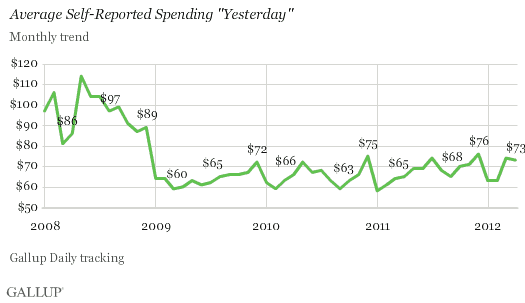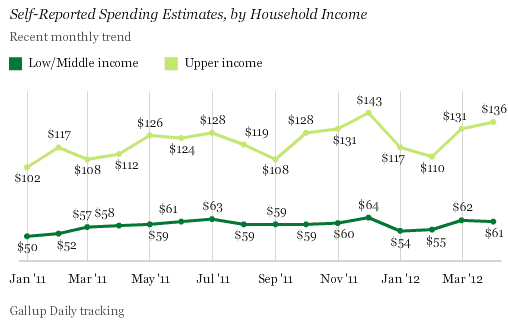PRINCETON, NJ -- U.S. consumers' self-reported daily spending in April averaged $73, little changed from March's $74 but one of the highest estimates Gallup has found since January 2009. The most recent estimate is also significantly higher than the $65 measured in April 2011.

The results are based on Gallup Daily tracking interviews with more than 13,000 Americans in April. Gallup asks Americans to report how much they spent the prior day outside of the purchase of a home, motor vehicle, or normal household bills. The figures thus give an estimate of discretionary spending.
Gallup finds that daily spending has exceeded $70 in each of the last two months, marking only the second time since 2009 -- and the first since October-December 2011 -- that spending has been at or above the $70 mark in consecutive months.
Gallup's monthly averages of reported daily spending have typically been in the $60 range since 2009, as Americans pulled back in response to the financial crisis, launching a "new normal" era of reduced spending. Since then, spending has averaged above $70 in just a few months, most often in December, when the bulk of holiday spending takes place.
Gallup does not ask consumers to specify what they are spending money on, so it is unclear whether the higher March and April estimates to some degree reflect the impact of higher gas prices. Consumers have reported spending slightly more in March and April than in February over the last few years, so another possibility is a seasonal effect, perhaps tied to warmer weather or income tax refunds.
Notably, low- and middle-income consumers, as well as high-income consumers, reported spending more on average during the last two months. On a few occasions last year when Gallup saw increases in spending, it was due to higher spending among upper-income Americans.

Also, low- and middle-income consumers' spending estimates have been at least somewhat higher each month this year than in the same month last year, suggesting a real trend toward higher spending in 2012 than in 2011.
Implications
Americans seem to be more inclined to spend than they have at almost any point in the last few years, since spending fell out of favor after the financial crisis. A key for the U.S. economy, whose growth is largely driven by consumer spending, is whether that momentum toward higher spending can be maintained in the coming months. In each year that Gallup has tracked spending, its May estimates have exceeded those from April, so if that pattern holds, Americans may spend even more this month.
Gallup.com reports results from these indexes in daily, weekly, and monthly averages and in Gallup.com stories. Complete trend data are always available to view and export in the following charts:
Daily: Employment, Economic Confidence, Job Creation, Consumer Spending
Weekly: Employment, Economic Confidence, Job Creation, Consumer Spending
Read more about Gallup's economic measures.
View our economic release schedule.
Survey Methods
Results are based on telephone interviews conducted as part of Gallup Daily tracking April 1-30, 2012, with a random sample of 13,642 adults, aged 18 and older, living in all 50 U.S. states and the District of Columbia.
For results based on the total sample of national adults, one can say with 95% confidence that the maximum margin of sampling error is ±1 percentage points.
The estimates for average daily spending have a margin of sampling error of ±$4.
Interviews are conducted with respondents on landline telephones and cellular phones, with interviews conducted in Spanish for respondents who are primarily Spanish-speaking. Each sample includes a minimum quota of 400 cell phone respondents and 600 landline respondents per 1,000 national adults, with additional minimum quotas among landline respondents by region. Landline telephone numbers are chosen at random among listed telephone numbers. Cell phone numbers are selected using random-digit-dial methods. Landline respondents are chosen at random within each household on the basis of which member had the most recent birthday.
Samples are weighted by gender, age, race, Hispanic ethnicity, education, region, adults in the household, and phone status (cell phone only/landline only/both, cell phone mostly, and having an unlisted landline number). Demographic weighting targets are based on the March 2011 Current Population Survey figures for the aged 18 and older non-institutionalized population living in U.S. telephone households. All reported margins of sampling error include the computed design effects for weighting and sample design.
In addition to sampling error, question wording and practical difficulties in conducting surveys can introduce error or bias into the findings of public opinion polls.
For more details on Gallup's polling methodology, visit www.gallup.com.
